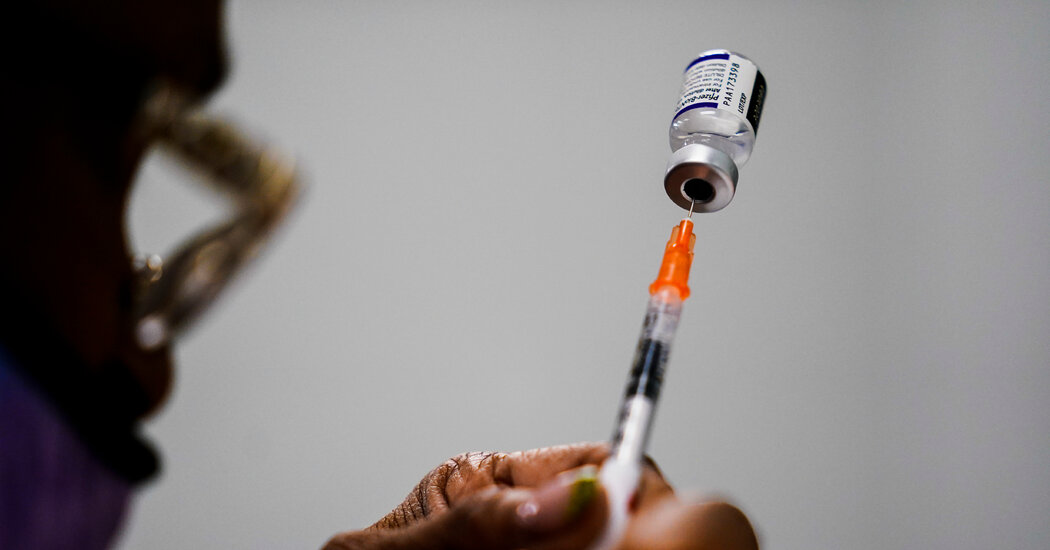
WASHINGTON — The Food and Drug Administration on Wednesday authorized the first redesign of coronavirus vaccines since they were rolled out in late 2020, setting up millions of Americans to receive new booster doses targeting Omicron subvariants as soon as next week.
The new formulation arrives as roughly 90,000 infections and 475 deaths are still being recorded daily around the United States, more than two years into a pandemic that has killed more than a million Americans and driven a historic drop in life expectancy.
With winter approaching and the BA.5 variant of Omicron still circulating widely, federal officials hope the redesigned shots will help slow the pandemic’s seemingly relentless march. Yet many Americans appear to have become indifferent to the virus and its risks, making the task tougher than ever.
The new boosters are “bivalent,” meaning they contain a combination of the original formulation and one targeting BA.5, now the dominant version of the virus, as well as a sister subvariant of Omicron. One is made by Pfizer and its German partner BioNTech for use in people as young as 12, and the other by Moderna, for those 18 and older.
Officials in the Biden administration have argued that even as researchers work to understand how protective the new shots might be, inoculating Americans again in the coming weeks could better equip adolescents and adults if cases surge again.
“The idea here is not just to increase the antibodies right now, but also to hopefully give us a longer duration of protection” that will hold up through the winter, Dr. Peter Marks, the top vaccine regulator at the F.D.A., said at a news briefing on Wednesday.
Even though case counts remain high, fewer than 40,000 people are hospitalized with the virus, a decrease of 10 percent since early August and far fewer than during the Delta-driven surge last summer or the Omicron-fueled wave last winter. Deaths have also remained somewhat flat in recent weeks, a sign that vaccines are helping to prevent the worst outcomes of Covid-19.
People who have been fully vaccinated are eligible for the updated shots, regardless of whether they have also received booster doses. But their last shot must have been at least two months ago.
The new boosters could be available in a few days, assuming that Dr. Rochelle P. Walensky, the director of the Centers for Disease Control and Prevention, signs off, a decision that could come by Friday. The federal government was expected to start shipping doses to the states as soon as the F.D.A. acted.
Ample evidence suggests that many Americans will hold back from additional shots, either because they are weary of the pandemic or may not feel urgency about an additional dose. With each new shot offered, there are fewer takers.
Read More on the Coronavirus Pandemic
Some states and localities are also cutting back on programs to offer shots, and federal reimbursement for certain vaccine-related expenses, like setting up sites, has shrunk.
Dr. Walensky criticized the lack of resources in an interview earlier this month. “I really thought that after Covid, people would understand that we really need this robust infrastructure,” she said. “Yet here we are in August 2022, and we don’t have resources for the huge vaccine rollout in the fall.”
The companies produced the retooled shots with extraordinary speed, a testament to the mRNA technology that Pfizer and Moderna have harnessed since the early months of the coronavirus outbreak. The F.D.A. told the companies only two months ago which formulation they should use for the new vaccines. By later this week, millions of those doses will be delivered to states.
The tight timeline meant that federal regulators had less data on the redesigned boosters than on any previous coronavirus vaccine, generating controversy. Regulators authorized the vaccine without results from human trials, which have just gotten underway.
Dr. Robert M. Califf, the F.D.A. commissioner, cautioned at the Wednesday briefing that regulators did not know exactly when they might see robust clinical data on how well the bivalent boosters work.
“If we jump to preliminary data, we can be easily misled one direction or the other,” he said. “No one’s more anxious than we are to have the data available and to get it out there once we have solid data to talk about.”
John Wherry, director of the Institute for Immunology at the University of Pennsylvania, said that even if the half of the vaccine that targets BA.5 doesn’t work well, recipients should still reap some benefit from the portion of the original vaccine.
“The gamble is we’re not going to get as much improvement against BA.5 as we had hoped,” he said. “I don’t see that as much of a gamble.”
For now, the F.D.A. is relying on the results of mouse trials and earlier human trials by Pfizer and Moderna of reformulations aimed at earlier versions of the virus.
The Biden administration is casting the bivalent shots as a standard upgrade that Americans should embrace ahead of potential surges in the winter. It has compared them to the flu shot, which is reconfigured every year to target more current versions of the influenza virus.
Dr. Marks said that a possible fall wave could peak around Dec. 1, so rolling out boosters could help control current infections and protect against a future surge.
The boosters are arriving during a period when the White House has been largely quiet on the pandemic. President Biden has rarely commented on the coronavirus in recent months, even after he tested positive in July. The White House no longer holds regular news briefings on the federal pandemic response, as it did in the first year of the administration — a reflection of the weariness of many Americans in keeping up with Covid precautions.
New polling conducted by Morning Consult found that Americans were less anxious about the virus, including the very liberal, who were once among the most cautious.
“Covid-19 is the third-leading cause of death in the United States. And it’s as if we’ve just accepted that that is going to be the case,” said Mercedes Carnethon, an epidemiologist at Northwestern University’s Feinberg School of Medicine.
Vaccinations remain the cornerstone of the federal government’s Covid strategy, even with tests and treatments widely available. The Biden administration has ordered over 170 million doses for the fall campaign, and officials do not expect shortages when they are rolled out.
“If it’s freezing cold out and you have children, you’re going to dress them warmly. This is the concept here,” said Dr. Paul G. Auwaerter, the clinical director of the infectious diseases division at the Johns Hopkins University School of Medicine. “You’ll want to head into the respiratory season with a virus that we know has surprised us with a booster.”
Dr. Marks said on Wednesday that regulators hoped the redesign would elevate antibody levels in a way that would restore the protection conferred by the initial vaccines against symptomatic infection in many people. But Dr. Auwaerter and other experts said that researchers would still need to know more about how antibody levels from the new formulations translated to protection, and what other measurements might be needed.
Both Dr. Califf and Dr. Marks said the government will also need to collect data on the ground on how well the shots work. “The proof will be in the pudding,” Dr. Califf said.
Experts warned against trying to choose Moderna’s shot over Pfizer’s or vice versa; with research in humans just beginning, scientists are at least weeks away from knowing whether one brand offers better protection than the other.
Many Americans have recently been infected with variants in the Omicron family and have some protection from their bouts with the virus, a development that the Centers for Disease Control and Prevention may take into account in its own recommendations on how the new shots should be used. An advisory committee to the C.D.C. is scheduled to meet this week to decide on recommendations.
“For most people, the risk of death is so low at this point because they’ve gotten infected or vaccinated, or more likely both,” said Dr. Gregory A. Poland, a professor of medicine and infectious diseases and the director of the Vaccine Research Group at the Mayo Clinic.
Dr. Poland, who has advised Moderna, Pfizer and White House officials on coronavirus vaccines, said updating booster shots the way the Food and Drug Administration did on Wednesday amounted to a “chase your tail” strategy, tweaking the design incrementally to try to keep up with a fast-changing virus. Such a strategy could be vulnerable to new and surprising variants that could complicate the federal vaccination program, experts have said.
In the meantime, Dr. Poland said, the new boosters could potentially save some lives among the elderly and those with immune deficiencies. But they were unlikely to make as substantial an impact with the rest of the population.
Asked on Wednesday how the new booster campaign would help younger, healthier Americans, Dr. Califf and Dr. Marks suggested they could prevent cases of long Covid, when sometimes debilitating symptoms can linger indefinitely beyond an early bout with an infection.
“Far and away the No. 1 thing is to get the high-risk people vaccinated,” Dr. Califf said. “But I think we’ve also been heavily influenced by the emerging data about long Covid.”




